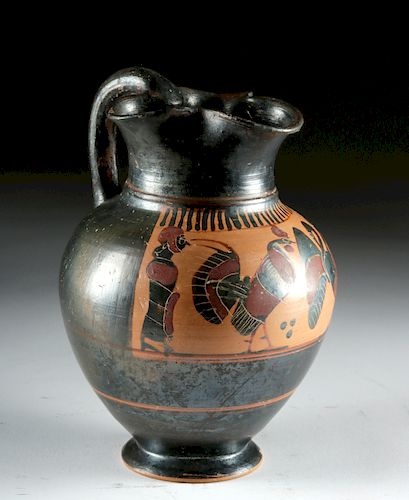Greek Euboean Terracotta Trefoil Oinochoe
Lot 25
About Seller
Artemis Fine Arts
686 S Taylor Ave, Ste 106
Louisville, CO 80027
United States
Selling antiquities, ancient and ethnographic art online since 1993, Artemis Gallery specializes in Classical Antiquities (Egyptian, Greek, Roman, Near Eastern), Asian, Pre-Columbian, African / Tribal / Oceanographic art. Our extensive inventory includes pottery, stone, metal, wood, glass and textil...Read more
Estimate:
$12,000 - $16,000
Absentee vs Live bid
Two ways to bid:
- Leave a max absentee bid and the platform will bid on your behalf up to your maximum bid during the live auction.
- Bid live during the auction and your bids will be submitted real-time to the auctioneer.
Bid Increments
| Price | Bid Increment |
|---|---|
| $0 | $25 |
| $300 | $50 |
| $1,000 | $100 |
| $2,000 | $250 |
| $5,000 | $500 |
| $10,000 | $1,000 |
| $20,000 | $2,500 |
| $50,000 | $5,000 |
| $100,000 | $10,000 |
| $200,000 | $20,000 |
About Auction
By Artemis Fine Arts
Feb 21, 2019
Set Reminder
2019-02-21 10:00:00
2019-02-21 10:00:00
America/New_York
Bidsquare
Bidsquare : Exceptional Antiquities, Asian, Ethnographic
https://www.bidsquare.com/auctions/artemis-gallery/exceptional-antiquities-asian-ethnographic-3858
An important one-day auction featuring museum-worthy examples of Egyptian, Greek, Roman, Etruscan, Near Eastern, Far East / Asian, Pre-Columbian, African / Tribal, Oceanic, Native American, Spanish Colonial, Russian, Fossils, Ancient Jewelry, Fine Art, so much more! Artemis Fine Arts info@artemisfinearts.com
An important one-day auction featuring museum-worthy examples of Egyptian, Greek, Roman, Etruscan, Near Eastern, Far East / Asian, Pre-Columbian, African / Tribal, Oceanic, Native American, Spanish Colonial, Russian, Fossils, Ancient Jewelry, Fine Art, so much more! Artemis Fine Arts info@artemisfinearts.com
- Lot Description
Greece, Euboea, ca. 3rd quarter of the 6th century BCE. An elegant, wonderfully preserved example of a black-figure painted, ceramic trefoil oinochoe. It stands on a delicate, flared disc foot, and has a wide, bulging body that tapers upward to a wide, pinched neck. A delicate, rounded handle flows from the shoulder upward to the back of the rim, where it is seamlessly integrated. Around the body on the side opposite the handle is a wide panel featuring a black-figure scene of a standing human figure draped in clothing and observing a rooster and a swan/goose. The birds are massive compared to the human, standing just as tall and presenting imposing figures. Size: 4.85" W x 7.25" H (12.3 cm x 18.4 cm)
This is a strong example of the black figure technique in which the figural and decorative motifs were applied with a slip that turned black during firing, while the background was left the natural color of the clay. The vase painter also took the time to incise the slip in order to delineate individual features and gestures. Further embellishing the artwork are broad wine red bands of pigment applied to each figure. Euboea, the large island northeast of Athens, is the second largest Greek island, after Crete. Their black-figure vases were inspired by Corinth and Attica - indeed, they can sometimes be hard to distinguish from those made in Athens - and their use seems to have been restricted to funerary contexts.
Provenance: ex-private Chicago, Illinois, USA collection
All items legal to buy/sell under U.S. Statute covering cultural patrimony Code 2600, CHAPTER 14, and are guaranteed to be as described or your money back.
A Certificate of Authenticity will accompany all winning bids.
We ship worldwide and handle all shipping in-house for your convenience.
#142030Small chips from foot and light wear on surface commensurate with age, otherwise in very good condition. Motifs are beautifully preserved with no overpainting.Condition
- Shipping Info
-
All shipping is handled in-house for your convenience. Your invoice from Artemis Gallery will include shipping calculation instructions. If in doubt, please inquire BEFORE bidding for estimated shipping costs for individual items.
-
- Buyer's Premium



 EUR
EUR CAD
CAD AUD
AUD GBP
GBP MXN
MXN HKD
HKD CNY
CNY MYR
MYR SEK
SEK SGD
SGD CHF
CHF THB
THB
















